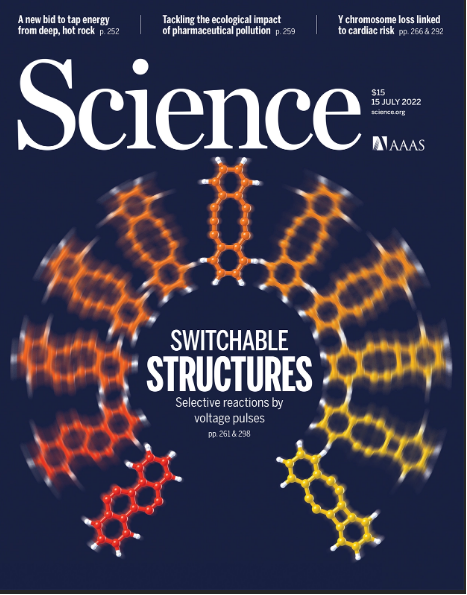"Science" (published 20220715) One -week thesis guide
Author:Scientific network Time:2022.07.17
Compilation | Weiyi
Science, 15 jul 2022, VOL 377, Issue 6603
"Science" July 15, 2022, Vol. 377, 6603

Astronomy Astronomy
SpaceCraft Sample Collection and Subsurface Excavation of Asteroid (101955) Bennu
Sample collection and underground excavation of the Astronomer (101955) "Bennu"
Author: d. s. Lauretta, C. D. Adam, A. J. Allen, R.-L. Ballouz, O. S. Barnouin, K. J. Becker, et al.
Link:
https://www.science.org/doi/10.1126/science.abm1018
Summary:
Small carbon stars, such as (101955) "Bennu", preserve the early material of the solar system, including volatile compounds and organic molecules.
The research team reported the spacecraft imaging and spectral data collected from the surface of "Bennu" and later collected. The sampling activity stirred the gravel and dust into a debris, and tapped a 9 -meter -long oval meteorite pit.
Compared with the original surface, the exposed material color is darker, the spectrum is more red, and the fine particles are richer. The volume density of the dug underground material is 500-700 kg/m3, which is about half of the volume density of the entire asteroid.
The particles falling on the instrument optical element are similar to the carbon meteorite similar to water erosion on the spectrum. In the end, 250 ± 101 grams of materials were stored and will be shipped back to Earth in 2023.
Abstract:
Carbonaceous asteroids, such as (101955) Bennu, preserve material from the early Solar System, including volatile compounds and organic molecules. We report spacecraft imaging and spectral data collected during and after retrieval of a sample from Bennu's surface. The sampling event mobilized rocks and dust into a debris plume, excavating a 9-meter-long elliptical crater. This exposed material is darker, spectrally redder, and more abundant in fine particulates than the original surface. The bulk density of the displaced subsurface material was 500 to 700 kilograms per cubic meter, which is about half that of the whole asteroid. Particulates that landed on instrument optics spectrally resemble aqueously altered carbonaceous meteorites. The spacecraft stored 250 ± 101 grams of material, which will be delivered to Earth in 2023.
Krypton in the Chassigny Meteorite Shows Mars Acci Volatiles Before Nebular Games
"Chassigny" meteorite shows that the accumulation of the Martian meteorite volatilizer is preceded by the Nebula Gas
Author: Sandrine Péron and Sujoy Mukhopadhyay
Link:
https://www.science.org/doi/10.1126/science.abk1175
Summary:
Volatile elements are considered to be transported to the solar land -class planet through the incense of the planet of the solar system. Mars can provide information on volatile substances during the formation stage of the internal planet of the solar system. The research group measured the isotopes in the Mars meteorite "Chassigny" representing the internal Mars. They have determined the ratio of the gallery meteorite isotope, which means that the chinensis meteorite is absorbed earlier.
Mars atmosphere has a different (Sun Nebula) isotope ratio, which indicates that it is not the product of the magma ocean deflation or internal volatile distillation. On the contrary, the ines in the atmosphere originated from the formation of the solar cloud gas before the emergence of the nebula.
The observation result contradicts that the general assumptions, that is, during the formation of the planet, the transportation of the gallery meteorite volatilization occurs after the solar gas accumulation.
Abstract:
Volatile elements are thought to have been delivered to Solar System terrestrial planets late in their formation through accretion of chondritic meteorites. Mars can provide information on inner Solar System volatile delivery during the earliest planet formation stages. We measured krypton isotopes in the martian meteorite Chassigny, representative of the planet's interior. We found chondritic krypton isotope ratios, which imply early incorporation of chondritic volatiles. The atmosphere of Mars has different (solar-type) krypton isotope ratios, indicating that it is not a product of magma ocean outgassing or fractionation of interior volatiles. Atmospheric krypton instead originates from accretion of solar nebula gas after formation of the mantle but before nebular dissipation. Our observations contradict the common hypothesis that during planet formation, chondritic volatile delivery occurred after solar gas acquisition.
Physics Physics
Thermalization dynamics of a gauge theory on a quantum simulator
The thermal dynamics of the standard field theory on the quantum simulator
Author: zhao-yu zhou, guo-xian su, jad c. halimeh, robert ott, hui sun, philipp hauke, et al.
Link:
https://www.science.org/doi/10.1126/sclence.abl6277
Summary:
The standard field theory has formed the foundation of modern physics, and its application scope is from basic particle physics, early cosmic science to condensed material system.
The research team carried out quantum simulation of the dynamics of U (1) symmetrical specification field theory and proved the irreversible behavior of emerging. High-constrainting standard field dynamic coding is in a one-dimensional Bolk-Hubel simulator, and the Michael Material Farm is coupled by dynamic specification fields.
The research team explored the balance of quantum quantum and approximate steady state through the thermal system. This work may help to study elusive phenomena, such as Schwen Ge to break the chord to break, and lays the foundation for the simulation of more complex and higher -dimensional standard field theory on the quantum synthetic material device.
Abstract:
Gauge theories form the foundation of modern physics, with applications ranging from elementary particle physics and early-universe cosmology to condensed matter systems. We perform quantum simulations of the unitary dynamics of a U(1) symmetric gauge field theory and demonstrate emergent irreversible behavior. The highly constrained gauge theory dynamics are encoded in a one-dimensional Bose-Hubbard simulator, which couples fermionic matter fields through dynamical gauge fields. We investigated global quantum quenches and the equilibration to a steady state well approximated by a thermal ensemble. Our work may enable the investigation of elusive phenomena, such as Schwinger pair production and string breaking, and paves the way for simulating more complex, higher-dimensional gauge theories on quantum synthetic matter devices.Visualizing Eigen/Zundel cations and their interconversion in monolayer water on metal surfaces
This sign/Zeng Deryang ion and its interdependence in the metal surface single -layer water visualization
Author: Ye Tian, Jiani Hong, Duanyun Cao, Sifan You, Yizhi Song, Bowei Cheng, et al.
Link:
https://www.science.org/doi/10.1126/sclence.abo0823
Summary:
The nature of hydrophilic protons in solid surfaces is very important in electrochemical, proton channels, and hydrogen fuel cells, but due to lack of atomic scale, the current nature is not clear.
Under ultra -high vacuum, the research team used low -temperature QPLUS atomic microscope to observe AU (111) and PT (111) on the surface of the hydrogen bonding water network and Zeng Del -type hydraulic proton.
They found that this Zhengyang ion was self -assembled into a single -layer structure with a local area, and Zeng Delyang ion forming a long -range ordered structure with a stable nuclear quantum effect. The two cations can be combined into a Zeng Del cation, and the proton is transferred to the surface.
In addition, the research group also found that Zeng Del's configuration was better than this signs on PT (111), and there was no such bias on AU (111).
Abstract:
The nature of hydrated proton on solid surfaces is of vital importance in electrochemistry, proton channels, and hydrogen fuel cells but remains unclear because of the lack of atomic-scale characterization. We directly visualized Eigen- and Zundel-type hydrated protons within the hydrogen bonding water network on Au(111) and Pt(111) surfaces, using cryogenic qPlus-based atomic force microscopy under ultrahigh vacuum. We found that the Eigen cations self-assembled into monolayer structures with local order, and the Zundel cations formed long-range ordered structures stabilized by nuclear quantum effects. Two Eigen cations could combine into one Zundel cation accompanied with a simultaneous proton transfer to the surface. Moreover, we revealed that the Zundel configuration was preferred over the Eigen on Pt(111), and such a preference WAS ABSENT on AU (111). Material Science Materials Science
Efficient and Stable Perovskite-Silicon Tandem Solar Cells Through Contact Displacement by MGFX
MGFX contact position displacement to achieve efficient and stable perovskite-silicon string linked solar cells
Author: Jiang Liu, Michele de Bastiani, Erican Aydin, George T. Harrison, Yajun Gao, Rakesh R. Pradhan, et al.
Link:
https://www.science.org/doi/10.1126/sclence.abn8910
Summary:
The performance of the anti-polar (P-I-N) perovskite solar cells is still limited by the composite of the electronic extraction interface, which also reduces the power conversion efficiency (PCE) of P-I-N ofiler-sterrificeic solar cells.
The MGFX fixture with a thickness of about 1 nm at the interface of the perovskite/C60 interface can regulate the surface energy of the perovskite layer well through thermal evaporation, thereby helping effective electronic extraction, and replacing the C60 from the surface of the perovskite to reduce the non -radiation composite Essence
These effects make the opening voltage of a single piece of perovskite-silicon-stringed solar cells with an area of about 1 cm2 reached 1.92 volt, the filling factors increased to 80.7%, and the stable PCE of independent certification reached 29.3%.
In more than 1,000 hours of damp heat test (85 ° C, 85%relative humidity), the series battery maintains about 95%of the initial performance.
Abstract:
The performance of perovskite solar cells with inverted polarity (p-i-n) is still limited by recombination at their electron extraction interface, which also lowers the power conversion efficiency (PCE) of p-i-n perovskite-silicon tandem solar cells. A MgFx interlayer with thickness of ~1 nanometer at the perovskite/C60 interface favorably adjusts the surface energy of the perovskite layer through thermal evaporation, which facilitates efficient electron extraction and displaces C60from the perovskite surface to mitigate nonradiative recombination. These effects enable a champion open-circuit voltage of 1.92 volts, an improved fill factor of 80.7%, and an independently certified stabilized PCE of 29.3% for a monolithic perovskite-silicon tandem solar cell ~1 square centimeter in area. The tandem retained ~95% of its initial performance after damp-heat testing (85° C at 85% Relative Humidity) For & 1000 Hours.accelerated Aging of All-Inorganic, Interface-Stabilized Perovskite Solar Cells
Full inorganic interface Stabilize Flipholic ore Mine Solar Battery Accelerated Aging Test
Author: xiaoming zhao, tianran liu, quinn c. Burlingame, tianjun liu, rudolph holleyiiii, guangming cheng, et al.
Link:
https://www.science.org/doi/10.1126/sclence.abn5679
Summary:
In order to understand the degradation pathway of perovskite solar cells (PSCS) and improve its stability, it is necessary to perform accelerated aging tests. The research team used high -temperature (up to 110 ° C) to quantify the encapsulated CSPBII3PSCS to accelerate the degradation under constant light.
The introduction of two -dimensional (2D) CS2PBI2CL2 covering layer between the oscope active layer and the cave transmission layer can stabilize the interface, and at the same time increase the power conversion efficiency of the whole inorganic PSCS from 14.9%to 17.4%. Dengi with the 2D coverage layer will not degrade at 35 ° C, and it needs to be degraded by 20%of its initial efficiency at 110 ° C and constant light conditions.
Based on the degradable acceleration factors observed by Ajansius, the research group predicts that the inherent life of the PSCS continuously working at 35 ° C is 51000 ± 7000 hours (& 5 years).
Abstract:
To understand degradation routes and improve the stability of perovskite solar cells (PSCs), accelerated aging tests are needed. Here, we use elevated temperatures (up to 110℃) to quantify the accelerated degradation of encapsulated CsPbI3PSCs under constant illumination. Incorporating a two- dimensional (2D) Cs2PbI2Cl2 capping layer between the perovskite active layer and hole-transport layer stabilizes the interface while increasing power conversion efficiency of the all-inorganic PSCs from 14.9 to 17.4%. Devices with this 2D capping layer did not degrade at 35℃and required &2100 hours at 110℃ under constant illumination to degrade by 20% of their initial efficiency. Degradation acceleration factors based on the observed Arrhenius temperature dependence predict intrinsic lifetimes of 51,000 ± 7000 hours (&5 years) operating continuously at 35℃.编辑| 方圆
Capture | Zhihai






- END -
It ’s for half a year to overcome 5 seconds of animation to see how this game art company finds vitality in adversity?| The secret of the little giant

Cover Journalist Zhu ZhuRecently, the State Administration of Press and Publicati...
Ningling County Meteorological Bureau lifted the thunderstorm and windy yellow warning [III class/he
Ningling County Meteorological Observatory lifted the thunderstorm yellow warning signal released at 00:40 on June 9, 2022 at 00:40 on June 9, 2022.